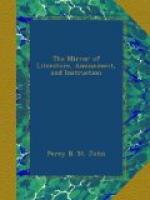George, eldest son of the above-named Robert Manners, succeeded to his father’s estates, including Belvoir: in his will, a copy of which is given by Mr. Nichols, dated Oct. 6, 1513, he is styled “Sir George Manners, knight, Lord Ros.” He was interred, with his lady, in a chantry chapel, founded by his father-in-law, Sir Thomas Ledger, in the chapel of St. George, at Windsor. His son, Thomas, Lord Ros, succeeded him, and was created by Henry VIII. a knight, and afterwards Earl of Rutland, a title which had never before been conferred on any person but of the blood royal. This nobleman aided Henry in the dissolution of the monasteries, and for his zeal received from the monarch several manors and estates. He caused many of the ancient monuments of the Albinis and the Rosses to be removed from the priory churches of Belvoir and Croxton to that of Bottesford. He also restored and in part rebuilt the castle, which had been in ruins since Hastings’s attack. The state of the castle at this period is thus described by Leland:—“It is a straunge sighte to se be how many steppes of stone the way goith up from the village to the castel. In the castel be two faire gates; and the dungeon is a faire rounde towere now turned to pleasure, as a place to walk yn, and to se al the counterye aboute, and raylid about the round (wall,) and a garden (plotte) in the midle. There is also a welle of grete depth in the castelle, and the spring thereof is very good.” Henry, the second Bard of Rutland, succeeded his father in 1543; and in 1556 was appointed captain-general of all the forces then going to France, and commander of the fleet, by Philip and Mary. Edward, the third earl, eldest son of the former, succeeded in 1563: Camden calls him “a profound lawyer, and a man accomplished with all polite learning.” John, a colonel of foot in the Irish wars, became fourth earl in 1587, and was followed by his son Roger, the fifth earl, who dying without issue, his brother Francis was nominated his heir, and made the sixth earl. He married two wives, by the first of whom he had only one child, named Catherine, who married George Villiers, the first Duke of Buckingham. Her issue, George, the second Duke of Buckingham, dying without an heir, the title of Lord Ros of Hamlake again reverted to the Rutland family. By a second marriage he had two sons, who, according to the monument, were murdered by wicked practice and sorcery.[3] George was created seventh earl in 1632; and was honoured with a visit from Charles I. at Belvoir castle, in 1634. The eighth earl was John Manners, who attaching himself to the Parliamentarians, the castle was attacked by the royal army, and lost and won again and again




